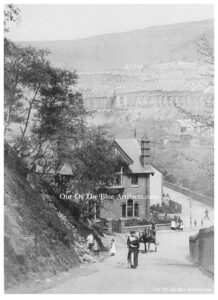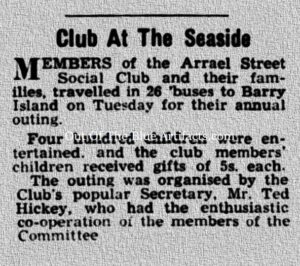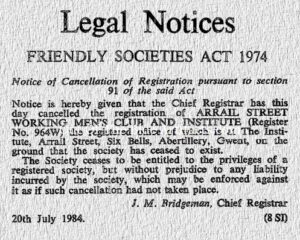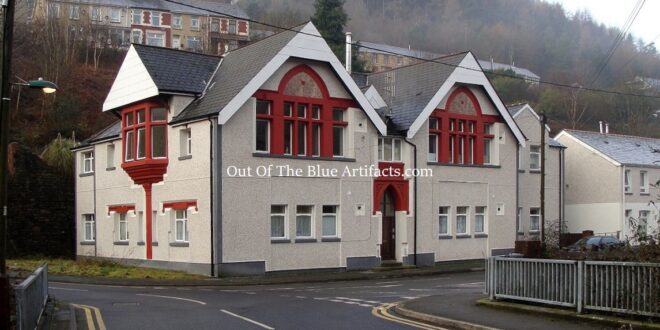Six Bells Miners Institute.
In 1902 the Arrael Griffin Colliery, Six Bells, owned by the Lancaster Co, had a miner’s institute built at a cost of £3,000. Mr Charles T. Part J.P., St Albans, Hertfordshire, one of the directors of the firm of Messrs John Lancaster & Co having performed the opening ceremony. It was intended that Mr Part would be the manager of the institute though there was to be a committee of management selected from the employees at the colliery.
The Arrael Griffin Collieries General Manager Mr J. J. Jeffreys was (Chairman). Other members included Mr J. Trilla, (Under-Manager); Mr A. Watkins (Clerk); Mr T. Rosser (Overman) and other representatives of various grades of workmen.
 Description of the Institute.
Description of the Institute.
The Six Bells Miners Institute (described at the time) was erected at the corner of the Arrael Road and built of Ruabon bricks with red Mansfield facings and the whole structure, which is enclosed within railings, presents a most pleasing appearance and is approached from the road. Over the entrance which faces the village there are the arms of Messrs John Lancaster & Co Ltd, a Griffin and Six Bells representing the old village, along with other floral decorations finely set in plaster.
Large bay windows afford good light to the smoking and billiard rooms which were on the left and right respectively as the institute was entered, over the windows there was a balcony which was reached from the landing on the first floor and large gables of half-timber set on the top of the building to great advantage. The smoking and billiard rooms were each 30’ft by 20’ft with a height of 12’ft and were each provided with refreshment bars.
In addition to the bay windows already mentioned, there were several windows on the side and all rooms throughout are well provided for in the way of light. In the smoking room there was a hydraulic lift which served the first floor with refreshments. A pitch-pine staircase led to the first floor and over the billiard room there was a spacious club room measuring 20’ft by 16’ft and on the right-hand side of the landing, reading and games rooms were provided, the latter containing two ping-pong tables and other occasional tables for chess, draughts etc.
A feature of the institute was the reading room which was supplied daily with local papers and periodicals etc. There was a splendid well lighted and commodious billiards room in which two full size tables were placed. Membership was entirely voluntary on the part of the workmen, the subscriptions were fixed at the nominal sum of 6d. per month, for which the member would be entitled to all the advantages of the institution, except as regards the billiards
The institute was well provided for in the matter of lavatory accommodation and was fitted throughout with electric bells and gas etc. Apartments for the caretaker had been arranged for at the back and everything had been done to meet the convenience of the club members
The institute provided alcohol, though this was limited to just beer and at a quantity of just three pints per member, per day, a rule which was strictly enforced.
The Contractor and Architect.
The contractor was Mr A. P. Williams of Abertillery. The architect was Mr C. Telford Evans of Cardiff. Mr Walker of Six Bells superintended the brickwork.
The Opening Ceremony.
On Monday 15th of December 1902, the Six Bells Miners Institute was officially opened. Present were Mr Charles T. Part J.P.; Mr M. Wolstenholme J.P., Managing Director, Blaina; Mr C. Telford Evans; Rev H. S. Rees of Abertillery; Mr J. Jeffreys; Dr Sullivan Esq and many others:
Mr Part unlocked the door with a silver key with which he was presented by the architect.
In a speech, Mr Part said, “The object he had in giving this institute was two-fold, first to provide a place for the men to have recreation after their work in the pit and secondly was to try and do what they could to make sure the men in the village drank less than they did at the present time”. He said, “The company paid a very large sum in wages and were told that a large amount went to the public house”. He said, “He had nothing to say against the public house, though he would rather their men join this institute where they could enjoy themselves in games or reading without feeling the need to drink”. He also stated that in these days of limited companies it was difficult for the masters and men to meet together, though he hoped that such an institution as this would show that the interests of masters and men were identical.
Later, Mr Jeffreys proposed a vote of thanks to Mr Part and said the district was very grateful to him and hoped he would come to the village again. Mr Willis seconded the motion which was carried with acclamation.
The party retired for light refreshment.
The Management of the Arrael Griffin Workmen’s Club and Miners Institute 1902-1937.
The Stewards and Secretaries of the Arrael Griffin Workmen’s Club and Miners Institute were as follows –
Mr Albert Watkins – Secretary (1906)
Mr George Lewis (1906 – 1915)
Mr Christopher Lewis – Secretary (1914)
Mrs Elizabeth Ann Thomas (1922 – 1923)
Mr Charles Nash (1924)
Mrs Annie Lewis (1925 – 1928)
Mr John Davis (1929)
Mr Edward Moxham (1930)
Mr Harry Scourfield (1931 – 1934)
Mr William Llewellyn Phillips – Secretary (1932)
Mr David Rees Davies (1935 – 1937).
The Arrael Griffin Workmen’s Club and Institute Struck off the Register.
On Saturday 12th of November 1932, Arrael Griffin Workmen’s Club and Institute closed and in December 1932 it was struck off the register, this was reported in the London Gazette. At this time, Mr William Llewellyn Phillips was the club’s secretary. There are many unanswered questions as to what happened at the club between 1932 and 1938.
(More information to come).
The Arrael Street Workmen’s Social Club.
The Arrael Griffin Workmen’s Club and Institute ceased to be a miner’s institute in the late 1930’s and had been converted into a social club.
In 1939 the old institute building was officially registered as the Arrael Street Social Club and had 383 members on its books.
The Proposed Extension to the Club.
In August 1954 tenders were invited from builders for an extension to the Arrael Street Social Club. (More information to come).
 The Annual Outing to Barry Island.
The Annual Outing to Barry Island.
On Tuesday 16th of August 1949, the Arrael Street Social Club organised a day trip to Barry Island. The report in the South Wales Gazette from the time (as seen right) stated that twenty-six buses left the club with four hundred children and club members, the children received gifts of five-shillings each. The outing was organised by the Club’s Secretary Mr Ted Hickey.
The Club and Institute Union National Darts Competition.
On Saturday 28th of June 1952, the final of the Club and Institute Union National Darts Knockout took place between Arrael Street Social Club and the Clarence Club, Wakefield at the Albany Club, Coventry. The final was over three legs 1,001 up. The Arrael Street Club won the competition 2-1 with Mr George Goldspink hitting a double-two to give the club the victory. It was reported that the last game was won with 42 darts. The Arrael Street Social Club team members were as follows – Mr Morgan Assender; Mr Edward Avery; Mr Fred Derrick; Mr Billy Fox (Captain); Mr George Goldspink; Mr Jack Mapp; Mr Dai Puddy; Mr Cliff Perry; Mr Ken Lewis; Mr Harold Challenger; Mr Jim Thomas and Mr Edgar Richards:
Abertillery Clubs Dart League (Section A).
In May 1968 the Arrael Street Social Club featured in the Abertillery Clubs Dart League (Section A) with the following teams – Blaenau Gwent Club (C). The Argoed Club (B). Cwmtillery Club. Aberbeeg (A). Blaenau Gwent (B). Rose Heyworth. The Excelsiors (A). Sofrydd Club (A). The Excelsiors (D). Blaentillery (B). Trinant (A). Oak Street. Blaentillery (C) and the Old Tyleryans.
The Arrael Street Social Club – Stewards and Stewardesses 1938 – 1984.
Mr Brinley Griffiths (1938)
Mr David J Griffiths (1950).
Mr George Brown (1957)
Mr Harold Mapp (1958 – 1959)
Mr Albert Trigg (1960 – 1961)
Mr James S. Hawkins (1962)
Mr Stanley Jones (1963 – 1967).
Mr John Daley (Dates unknown)
Mr Trevor Edwards (Dates unknown)
Mr Graham Wilsher (1976 – 1977)
Mr John Rocke (Dates unknown).
The complete list of management and landlords and landladies was kindly supplied courtesy of Mr Bryan Boots.
 The Closure of the Arrael Street Social Club.
The Closure of the Arrael Street Social Club.
The Arrael (Arrail) Street Social Club closed in the early 1980’s. The London Gazette (as seen left) issued a notification of the club’s status and that it had been struck off the Friendly Society’s Register on Friday 20th July 1984 as it ceased to exist.
The Club’s Conversion into Flats.
On Thursday 26th of May 1994, the Gwent Gazette reported on the much needed £350,000 flat conversions in Abertillery and Tredegar that were given the go ahead this year after the Welsh Office granted £175,000 towards the scheme. Work will take place in High Street, Abertillery and the old Arrael Street Club in Six Bells, Abertillery and at Commercial Street, Tredegar.
The Completion of the Renovation.
On Thursday 21st of March 1996, the Gwent Gazette correspondent, Mr Arthur Munn, reported on the completion of the renovation work on the Arrael Street club, it now contains eight flats.
Points of interest – The official name of the of the Six Bells Colliery was the Arrael Griffin Colliery No4 and No5. The numbers 4 and 5 related to its shafts, the colliery had two shafts numbered as 4 and 5. The other Griffin Collieries in the Messrs John Lancaster combine was the Griffin No1 (North Griffin) at Blaina and the South Griffin Collieries at Bournville, Blaina No2 and No3.
Arrael or Arrail Street.
There has been many variations of the name Arrail, on the 1880 ordnance survey maps of Six Bells there was an Aral Level Arrail Level and Arrail Cottages between Aberbeeg and Six Bells, this was ten-years before Messrs John Lancaster and Co opened the Arrael Griffin Colliery. On the 1901 maps this spelling changed to Arail and it even showed the colliery as such. The name Arrael appeared as the name of the colliery, the Arrael Griffin Colliery and along with the name Griffin, was believed to have lent its name to the then newly built streets, Arrael and Griffin Streets, although the name Arrail had long been used in the valley at Six Bells. The nearby school Arael School was spelt with one “r” and it seems it was named after the Arael Mountain upon which it was constructed. So, it is more than likely the name variants came from the mountain which overlooks the small village, used to name cottages, a coal level, a farm and major colliery, though its name has been corrupted over many years.
The Contractor Mr A. P. Williams.
The builder and contractor responsible for the construction of the Six Bells Miners Institute at Arrail Street was Mr Alfred Prosser Williams, Mr Williams was one of Abertillery’s largest building contractors. He was born on the 25th of March 1849. Some of the most well-known building projects completed by Mr Williams were as follows – The re-building St Michaels Church, the New Market Hall, the re-building of the Globe Hotel, the Abertillery Vicarage in Church Street, the Co-operative Store in Church Street, Abertillery, the Blaentillery School, Queen Street School, Arael School along with many other buildings and he also built a picture house at Blaina.
Mr A. P. Williams was said to have been the first person in Abertillery to have a private telephone installed in his residence Gwentland House, Oak Street, Abertillery. Upon his retirement he went to live at Herbert Hall, Crickhowell, he later came back to Blaina to supervise building work and lived at “Lismore House” New Bennett St, Blaina.
Mr Williams’ mother was a direct descendant of the Vaughan’s of Tretower Court, Crickhowell also Davy Gam who was killed at the battle of Agincourt 1415, and Knighted on the battlefield by King Henry V. Sir Davy Gam was a Llewellyn by name and was from the Herbert and Vaughan families.
 Out Of The Blue Artifacts A Library of a lifetime of collecting
Out Of The Blue Artifacts A Library of a lifetime of collecting
